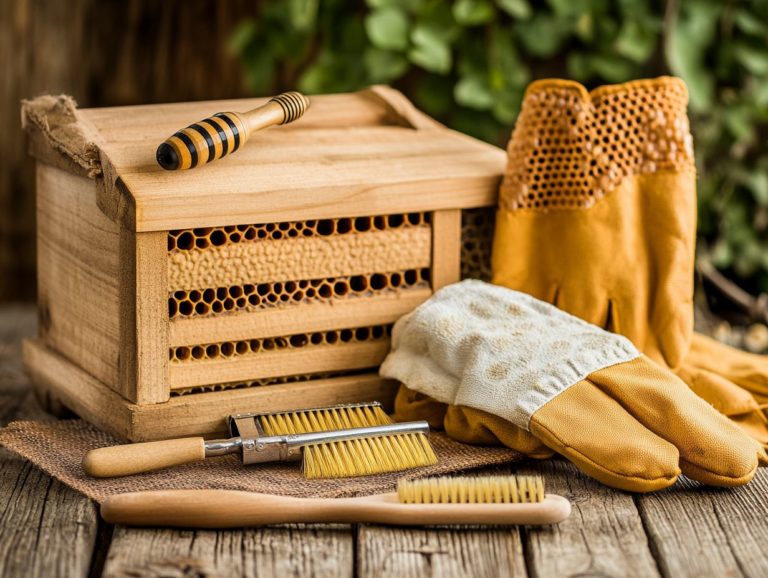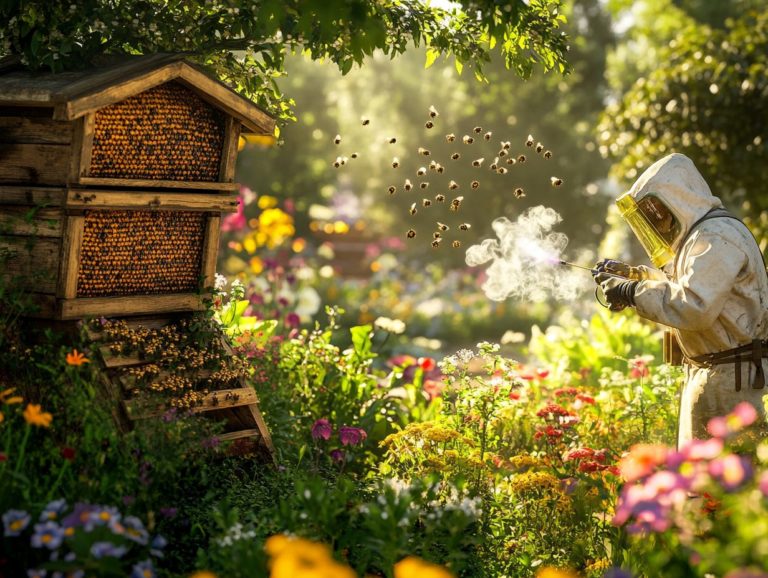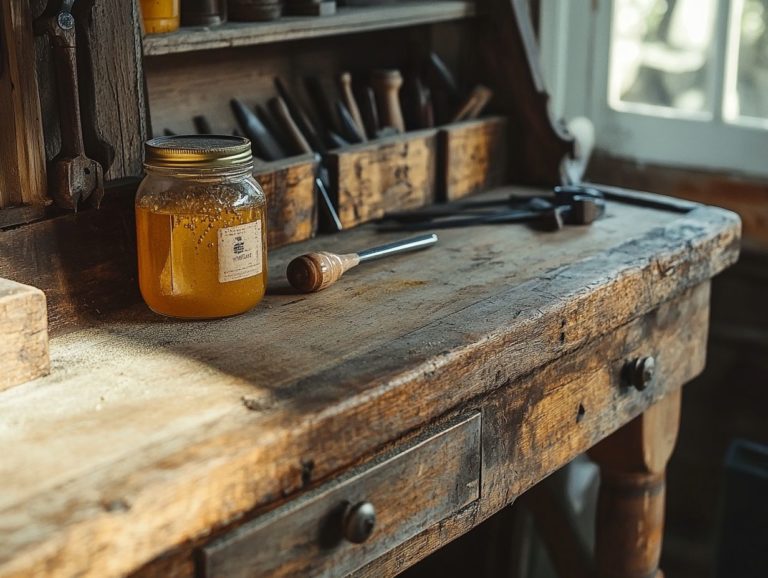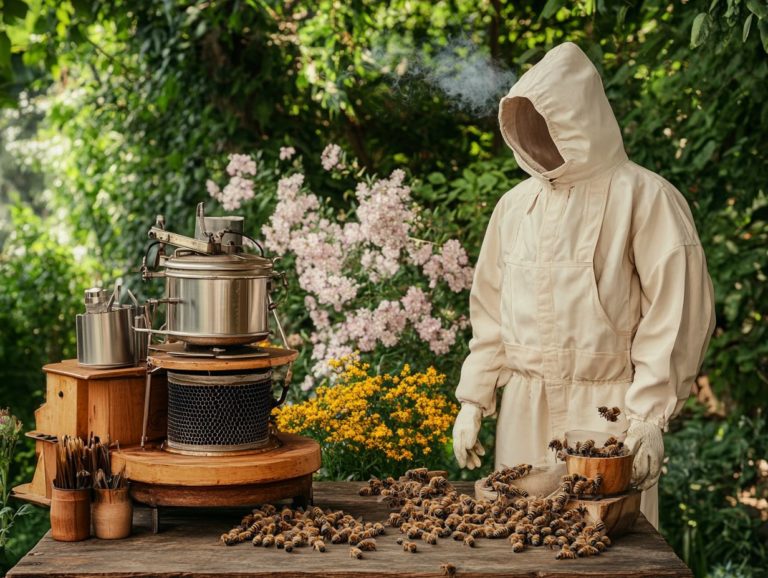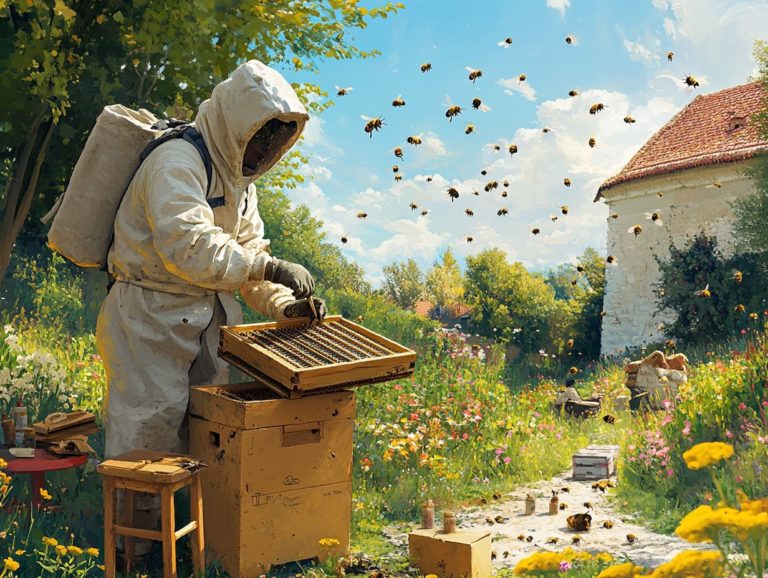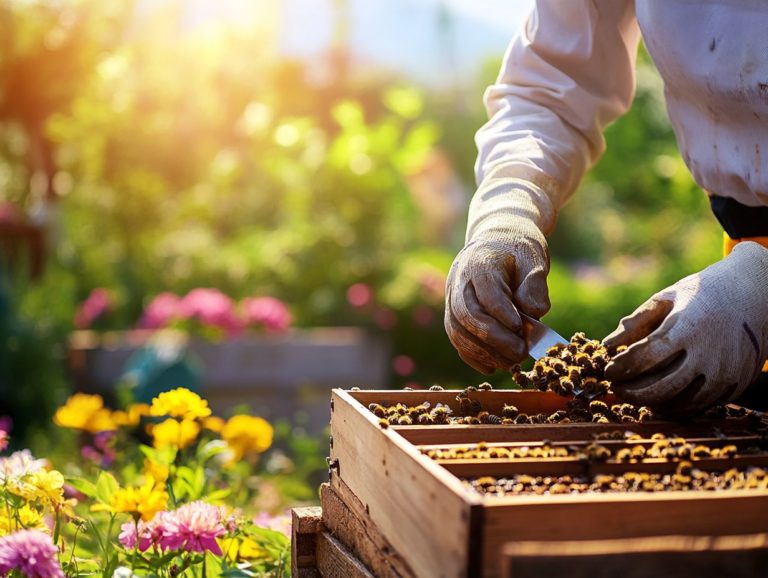How to Upgrade Your Beekeeping Equipment
Upgrading your beekeeping equipment can transform your apiary! It not only boosts efficiency and productivity but is also vital for safeguarding the health and safety of your bees.
In a constantly evolving beekeeping industry, it s essential to stay ahead with the latest tools and techniques. Whether you re grappling with outdated gear, planning to expand your operation, or looking to integrate innovative technology, this guide will immediately empower you with the best practices for upgrading your beekeeping equipment, ensuring your hive thrives.
Contents
- Key Takeaways:
- Why Should You Upgrade Your Beekeeping Equipment?
- When Should You Consider Upgrading Your Beekeeping Equipment?
- What Are the Essential Beekeeping Equipment to Upgrade?
- How to Choose the Right Upgraded Equipment for Your Beekeeping Operation?
- Tips for Maintaining and Caring for Your Upgraded Beekeeping Equipment
- Additional Resources
- Frequently Asked Questions
Key Takeaways:
- Upgrading your equipment is a game changer! It enhances efficiency, ensures bee safety, and keeps you up-to-date with industry standards.
- Consider upgrading when your equipment is damaged, when you expand operations, or when integrating new techniques.
- Essential upgrades include beehives, protective gear, smokers, and harvesting tools.
- Using sustainable materials and ergonomic features boosts long-term productivity and supports environmental preservation.
Why Should You Upgrade Your Beekeeping Equipment?
Upgrading your beekeeping equipment is crucial for elevating your operation, as it directly influences honey production, the health of your bee colonies, and the efficiency of your harvest.
With the latest advancements in beekeeping technology such as machines that help you extract honey with less effort and beehive monitoring systems you can optimize how you manage your colonies and enhance your honey yield. Tools like solar wax melters and ergonomic hive tools play a significant role in improving the efficiency and sustainability of your operation.
Investing in modern protective gear and hive tools ensures your safety during hive inspections and when handling bees. Choosing sustainable materials demonstrates your commitment to environmental preservation. Using breathable fabrics and ventilated suits offers you comfort and essential airflow while working with your colonies.
By selecting high-quality apiary equipment, you not only boost your productivity but also align yourself with the values of industry professionals dedicated to responsible beekeeping.
1. To Improve Efficiency and Productivity
Improving efficiency and productivity in your beekeeping endeavors can significantly elevate your honey production. This enables you to maximize the yield from your colonies while investing less time and labor. By integrating modern techniques and utilizing tools like automated honey extractors and solar wax melters, you can streamline your honey harvest process.
These automated tools lighten the physical load on you as a beekeeper and reduce the risk of harming your bees during extraction. Investing in hive tools, such as electric hive warmers and pheromone attractants, is essential for effective hive management, ensuring optimal conditions for your bees and leading to healthier colonies with increased output. Proper ventilation and ergonomic features in your equipment further enhance working conditions for both you and your bees.
Regularly upgrading your equipment, like replacing old frames or adopting advanced monitoring systems, keeps you in sync with the latest technology. This proactive approach to equipment maintenance fosters better hive health and significantly boosts overall productivity, making it an essential strategy for anyone serious about beekeeping.
Don’t wait upgrade your equipment today for better results in your beekeeping journey!
2. To Ensure the Safety of Your Bees
Ensuring the safety of your bees is crucial for a successful beekeeping operation. Upgrading your beekeeping equipment can significantly enhance their health and productivity. By investing in proper protective gear and advanced beehive monitoring systems, you can effectively manage your bee colonies, reducing stress and protecting them from harmful pests like varroa mites tiny parasites that harm bee colonies. Moreover, implementing insect management systems helps maintain a healthy and productive hive environment.
Regarding protective gear, ventilated suits and gloves are essential for safeguarding both you and your bees during hive inspections. These suits provide essential airflow while creating a protective barrier against stings, allowing you to work comfortably and confidently.
Regular inspections and advanced monitoring systems help you track the health metrics of your colonies. By keeping an eye on factors such as brood patterns and honey production, you ll be better equipped to tackle potential issues before they escalate. This nurtures a thriving ecosystem for both your bees and yourself. Regular hive checks and seasonal preparations are also crucial for maintaining colony health.
3. To Keep Up with Changing Industry Standards
Stay ahead in the beekeeping industry by keeping up with evolving standards and practices that influence honey production and the health of your bees. Upgrading your beekeeping equipment allows you to leverage the latest advancements, including sustainable materials and new tools for managing hives that are in line with current industry trends.
This includes functionality upgrades and performance upgrades that are indispensable for modern beekeeping. These innovations not only enhance the efficiency of your operations but also ensure your compliance with the growing regulations designed to protect pollinators and promote ethical practices.
Industry experts highlight that embracing sustainability is now more important than ever for long-term success. By adopting these advanced technologies, you can monitor hive conditions with greater precision, effectively reducing risks related to diseases and pests.
As environmental concerns intensify, integrate eco-friendly technologies now to boost both your productivity and compliance!
When Should You Consider Upgrading Your Beekeeping Equipment?
Determining the optimal moment to upgrade your beekeeping equipment is crucial for enhancing efficiency and ensuring the well-being of your bee colonies. Consider factors such as the condition of your existing gear, the specific goals of your beekeeping operation, and the seasonal preparations necessary for effective hive management, particularly during autumn preparation for winter.
These elements should inform your decision-making process, allowing you to make thoughtful choices that will benefit your operation and your bees.
1. When Your Current Equipment is Damaged or Worn Out
If your current beekeeping equipment is damaged or showing signs of wear, it’s a definite signal that an upgrade is in order to safeguard the safety and health of your bees. Regularly evaluating your equipment is essential; it helps you pinpoint potentially hazardous conditions that could jeopardize your bee colonies.
Routine inspections can uncover common signs of wear and tear, such as cracks in your hive boxes, rust on metal components, or frayed straps on your bee suits. By tackling these issues before they escalate, you can protect your investment and create a more productive environment for your bees.
Connecting with reputable businesses that specialize in beekeeping supplies gives you access to quality replacements or upgrades. These trusted suppliers typically offer well-designed, durable equipment that not only enhances your operational efficiency but also promotes better hive management, ultimately contributing to the overall health and productivity of your colonies.
Invest in quality replacements today to ensure a thriving bee colony!
2. When You Want to Expand Your Beekeeping Operation
When you decide to expand your beekeeping operation, upgrading your equipment becomes essential for managing additional bee colonies effectively. This means investing in new equipment used for managing bee colonies that streamlines hive management and supports queen rearing, both crucial for successful colony growth.
Expanding your beekeeping operation benefits from integrating new advancements and proper ventilation strategies to maintain optimal conditions in your hives. To scale your operations efficiently, incorporating additional beehives is imperative, as they grant the space needed for your burgeoning bee populations.
Implementing monitoring systems can significantly enhance your oversight of multiple hives. These systems enable you to track health metrics, honey production, and environmental conditions in real-time.
Having the right queen rearing equipment is vital for ensuring that new colonies thrive with well-grafted queens, which can substantially boost overall hive performance. Industry professionals recommend that you invest in high-quality, durable equipment; not only does this support productivity, but it also promotes healthier bee populations.
Don t forget to consider weather when planning your equipment upgrades! Engaging with local beekeeping associations can offer you invaluable insights and tips on best practices for managing this expansion effectively.
Beekeeping books authored by experts can be a valuable resource for learning new techniques and expanding your knowledge base.
3. When You Want to Incorporate New Techniques or Technology
Ready to transform your beekeeping operation? Incorporating new techniques or technologies into your beekeeping practice can significantly enhance your productivity and bee health, making it essential for you to consider upgrading your equipment.
For instance, automated honey extractors can streamline your honey harvest process, while advanced hive tools help maintain optimal conditions for your bee colonies. These innovations not only save you time but also reduce the physical strain associated with traditional methods.
Digital hive monitors allow you to track the temperature and humidity inside your hives remotely, ensuring your bees thrive in their environment. Integrated pest management systems use data to prevent and control pests effectively, helping to mitigate the risks of infestations.
Investing in solar wax melters and proper honey storage solutions can also optimize your honey production process. Many beekeepers who have embraced these advancements report higher honey yields and healthier colonies.
One local beekeeper shared, Since I started using digital monitors, I ve noticed a remarkable decrease in hive loss and a much more efficient harvesting process. This highlights how these technological tools are reshaping the future of beekeeping for the better.
Incorporating beekeeping essentials and focusing on equipment investment ensures long-term success and sustainability in your beekeeping endeavors.
What Are the Essential Beekeeping Equipment to Upgrade?
Upgrading your beekeeping equipment is a pivotal step toward elevating your beekeeping operation. Consider investing in essential tools, from robust beehives to top-notch protective gear, hive tools, and even automated honey extractors that can significantly enhance your experience.
Each piece of equipment serves a crucial function, ensuring not only the health of your bee colonies but also the efficiency of your harvesting methods and overall honey production.
1. Beehives
Upgrading your beehives can significantly boost your colony’s health. Don t miss out on this vital investment!
These structures serve as essential habitats for your bee colonies. Choose beehives made from eco-friendly materials with excellent insulation to enhance the health and productivity of your colonies.
As you explore the different types of beehives, you might find the traditional Langstroth hive, which is easy to manage and great for honey production. You should also consider top-bar and Warre hives, which allow your bees to thrive with minimal human intervention.
Each hive type presents unique advantages, from increased accessibility to improved ventilation. Selecting the right materials, like untreated wood or recycled elements, contributes to a healthier environment for your bees.
Regular maintenance of your hives is equally essential. It ensures that your colonies remain robust and resilient.
Upgrading to beehives equipped with modern features can enhance your bees ability to adapt to environmental changes, ultimately safeguarding their future.
2. Protective Gear
Get excited about investing in high-quality protective gear! It s crucial for your safety while working with bees during hive inspections and honey harvesting.
Options like ventilated suits made from breathable fabrics, along with gloves, hive tools, and ergonomic features, offer protection while keeping you comfortable.
For instance, you might choose suits with reinforced stitching and extra padding, which deflect bee stings and allow you to move easily. Some models even come with hoods featuring durable mesh for excellent visibility while keeping those buzzing bees at a safe distance.
Don t overlook the gloves; those lined with soft materials are crucial for maintaining dexterity when handling delicate equipment. For footwear, sturdy boots that withstand outdoor conditions are a must.
Each piece of gear enhances your confidence, allowing you to focus on your work without worrying about potential stings. This contributes to a more enjoyable and productive beekeeping experience.
3. Smokers
Smokers are critical tools for effective hive management. They enable you to calm your bee colonies during inspections with ease.
An upgraded smoker offers consistent smoke output, making it simpler to handle bees safely and efficiently.
You ll find a variety of smokers on the market, from classic metal models to contemporary designs with insulated walls for superior heat retention. These devices work by burning fuel like wood shavings or pine needles, producing a cool, aromatic smoke.
This smoke masks the alarm pheromones released by bees, minimizing their aggression. Proper insect management during hive checks is essential, as it safeguards the bees and ensures your safety as a beekeeper.
To use smokers effectively, ensure that your smoker is adequately fueled and check for proper airflow. By maintaining a calm demeanor and following best practices during inspections, you can enhance the overall experience for both yourself and your bees.
4. Harvesting Tools
Upgrading your harvesting tools is essential for maximizing honey production and ensuring an efficient harvest process. By investing in tools like automated honey extractors, you save time and contribute to the health of your bee colonies during honey extraction.
Recent advancements have introduced precision tools designed to make honey extraction safe and gentle for your bees. With features like temperature control and gentle handling mechanisms, these tools ensure that honey is extracted without harming the bees or compromising their well-being.
Choosing high-quality tools is a wise decision, as they enhance productivity and extend the lifespan of your equipment. Embracing automation in your beekeeping practices boosts your yield while cultivating a better environment for your bees.
This ultimately supports healthier ecosystems and promotes environmental preservation. What s better than a successful honey harvest? Upgrade your harvesting tools today!
How to Choose the Right Upgraded Equipment for Your Beekeeping Operation?
Selecting the ideal upgraded equipment for your beekeeping operation requires thoughtful consideration of several factors, such as your budget and unique needs. It’s also important to examine the range of available options.
By conducting thorough research on various tools and consulting reviews from seasoned beekeepers, you empower yourself to make informed choices. These choices will enhance the success of your apiary for years to come. This process can involve exploring new advancements and performance upgrades in beekeeping equipment.
1. Consider Your Budget
When upgrading your beekeeping equipment, keeping your budget in mind is essential. Your budget will dictate the quality and type of tools you can invest in.
Establishing a realistic budget enables you to prioritize essential beekeeping equipment. This ensures you source your items from reputable businesses.
Making a clear distinction between essential and non-essential items helps streamline this process. Essential tools, such as hives, protective gear, hive tools, and basic harvesting equipment, should take precedence in your budget.
Once you have secured these fundamental pieces, you can explore additional gadgets or amenities to enhance your beekeeping experience. Understanding that quality often trumps quantity will serve you well as a beekeeper.
Investing in durable, high-quality equipment can lead to fewer replacements over time, promoting long-term savings. Ultimately, strategic budgeting ensures that your operations run smoothly and efficiently, paving the way for better honey storage and a more productive beekeeping venture.
2. Research and Read Reviews
Researching and reading reviews on beekeeping equipment is essential for making informed decisions as you upgrade your tools. Consulting with seasoned beekeepers and seeking recommendations from reputable businesses can help you pinpoint high-quality equipment that aligns with your needs.
To truly excel in your beekeeping journey, dive deep into thorough research. Utilizing online resources like dedicated blogs and websites will provide you with invaluable insights and the latest trends in beekeeping technology.
Joining beekeeping forums enables you to exchange experiences with fellow enthusiasts. This helps you gain diverse perspectives on various products. Attending local meetups builds community and gives you the chance to see equipment in action firsthand.
Regarding reviews, focus on identifying patterns and recurring comments shared among users. This collective wisdom can steer you toward trusted products while helping you sidestep common pitfalls.
3. Consult with Experienced Beekeepers
Consulting with experienced beekeepers is invaluable when considering upgrades. Their insights can guide you to effective beekeeping techniques and the best equipment choices.
Engaging with industry professionals allows you to tap into a wealth of information and practical experiences that are hard to find elsewhere. Learning from seasoned beekeepers enhances not only your understanding of sound practices but also unlocks networking opportunities essential for growth.
They often grant access to shared resources, such as specialized tools or bulk purchasing options. These can help you save on costs and include tips on effective colony health management and autumn preparation.
When you meet with them, ask questions like, “What upgrades have you found most beneficial for your hives?” or “Can you recommend any suppliers that offer quality, affordable equipment?” You can also ask about specific tools such as solar wax melters or queen rearing equipment.
Leveraging their advice can streamline your decision-making process. This ensures your investments lead to healthier hives and a more productive beekeeping experience.
Tips for Maintaining and Caring for Your Upgraded Beekeeping Equipment
After upgrading your beekeeping equipment, make sure to give it the care it deserves! This not only extends the lifespan of your tools but also ensures that your operation runs seamlessly.
Prioritize proper maintenance and care to promote bee health and overall functionality upgrades. By diligently following maintenance tips and adhering to the manufacturer s instructions, you can keep your equipment in prime condition.
Don t wait start caring for your tools today to ensure a fruitful beekeeping season!
1. Regular Cleaning and Inspection
Clean and inspect your beekeeping equipment regularly. This helps maintain functionality and keeps your bee colonies healthy.
This proactive approach extends the lifespan of your gear and enhances overall productivity. Use a mild soap solution and warm water to clean your tools thoroughly, followed by a gentle drying process to avoid rust. Inspect wooden components for cracks or signs of rot, as these can lead to hive collapses that threaten your bees.
Establish a comprehensive checklist to streamline your maintenance routine and facilitate better hive management. Your regularly scheduled inspections should include:
- Checking frames for wear and damage
- Check that your protective gear is in great shape for safe beekeeping!
- Verifying that entrance reducers are functioning properly to guard against intruders and pests
By following these steps, you can create a more effective and sustainable environment for your colonies, ultimately benefiting honey production and bee health.
2. Proper Storage
Proper storage of your beekeeping equipment is essential for safeguarding it against environmental factors. Store your tools in a clean, dry space to prevent rust, damage, and degradation.
Pay attention to the unique requirements of different items in your beekeeping kit. For instance, your protective gear, such as gloves and suits made from breathable fabrics, should be kept in a well-ventilated, cool area to ward off mold and mildew. Meanwhile, hive tools need to be stored away from moisture to avoid corrosion.
Seasonal changes influence how you should store this equipment. During winter months, thoroughly clean and organize your tools to protect them from excess humidity and extreme temperatures. Regular inspections of the storage area will ensure that all items remain in optimal condition.
Get your equipment ready this autumn! Proper preparation boosts functionality and guarantees a successful honey harvest.
3. Follow Manufacturer’s Instructions
Following the manufacturer’s instructions for your beekeeping equipment is essential for proper usage and maintenance. This directly influences both your honey production and the health of your bees.
By adhering to specific guidelines for each tool, including machines that help extract honey efficiently, you guarantee safety and optimize performance.
Many beekeepers underestimate the significance of these instructions. Ignoring them can lead to issues like equipment malfunction and unsafe handling practices, which may harm your bees or the integrity of the honey you produce.
For example, failing to assemble or calibrate your hive correctly risks exposing your bees to diseases. Similarly, improper use of a smoker or protective gear may heighten the risk of stings.
These oversights can jeopardize the welfare of your bees and the quality of your honey. Therefore, both novice and seasoned beekeepers should prioritize reading and understanding the provided instructions to ensure they follow the best beekeeping techniques.
Additional Resources
Frequently Asked Questions
Why Upgrade Your Beekeeping Equipment?
Upgrading your beekeeping equipment boosts the efficiency and productivity of your operation. It also protects your bees and helps you meet industry standards while caring for the environment.
How Often Should You Upgrade Your Beekeeping Gear?
To keep your beekeeping gear in top shape, aim to upgrade at least every five years. Regular evaluations help you identify the right time for upgrades.
What Equipment Should You Prioritize?
Focus on upgrading essential items like protective gear, hives, and frames. These upgrades are vital for your bees’ well-being and your operation s success.
Consider investing in automated honey extractors, which simplify the extraction process, and beehive monitoring systems to keep track of your bees’ health.
What Factors Matter When Choosing New Equipment?
When selecting new equipment, look for quality, durability, and compatibility with what you already own. Ensure the equipment suits your bee species and the local climate.
Choose sustainable materials from trustworthy manufacturers for long-lasting benefits.
Can You Upgrade Your Equipment Yourself?
While DIY upgrades are possible, it s best to seek professional guidance. This ensures proper installation and reduces the risk of accidents that could harm your bees.
Consult beekeeping books and industry experts for valuable tips on a successful upgrade.
How to Dispose of Old Equipment Sustainably?
To dispose of old or damaged equipment, contact your local waste management agency for guidelines. Proper disposal safeguards the environment and supports fellow beekeepers.

